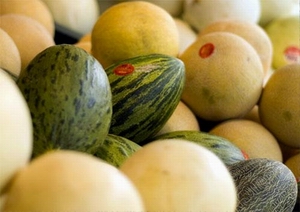Dutch health authorities have taken a batch of Spanish yellow melons off the market due to traces of Carbofuran being found in them, according to sources from the Rapid Alert System for Food and Feed (RASFF).
health authorities have taken a batch of Spanish yellow melons off the market due to traces of Carbofuran being found in them, according to sources from the Rapid Alert System for Food and Feed (RASFF).
According to the statement made by Dutch authorities to RASFF on 19 August, the melons have also been distributed in Austria, Germany, Lithuania, Sweden and the United Kingdom.
In the analyses conducted, Carbofuran concentrations of 0.03 mg/kg were found, surpassing the highest legal limit of 0.01 mg/kg.
Carbofuran is a contact and systemic acting pesticide, used against insects, larvae and nematodes. It is used in soil treatments, as it is absorbed through the roots and transferred to the entire plant, acting during the first stages of crop development.
Illegal pesticide
In the European Union (EU), as a result of a decision from the European Commission on 13 June 2007, no more authorisations were granted to products containing Carbofuran, due to its negative effects on human health and the environment.
December 2008 was the deadline for the withdrawal from the market of all products containing this toxic chemical.
Carbofuran is included in the Consolidated List of Forbidden and Restricted Products by the United Nations and in the list of dangerous pesticides and chemical products, making it subject to the Prior Informed Consent Procedure (PIC) of the Rotterdam Convention, which entails that the import of Carbofuran, as a dangerous substance, is subject to prior consultation in each country, which has to decide if it accepts it or refuses it, depending on its own legislation.
Highly dangerous, according to WHO
The World Health Organisation (WHO) classifies Carbofuran within the 1b group, which means "highly dangerous"; however, in the case of direct ingestion or via traces in food, it is "extremely toxic".
Effects
This pesticide can cause skin irritation and, depending on how it enters the human body, it can affect the respiratory system (asphyxiation), the digestive system (nausea, vomiting, salivation, cold sweat, abdominal pain, diarrhoea) and eyes (tearing, double vision, miosis, constriction of the pupil).
At higher levels of exposure, it can cause muscle spasms, lack of coordination and respiratory arrest.
The respiratory problems are those characteristic of a pulmonary edema, which is normally a symptom of acute carbamate poisoning.
It is also considered a carcinogenic substance.
 health authorities have taken a batch of Spanish yellow melons off the market due to traces of Carbofuran being found in them, according to sources from the Rapid Alert System for Food and Feed (RASFF).
health authorities have taken a batch of Spanish yellow melons off the market due to traces of Carbofuran being found in them, according to sources from the Rapid Alert System for Food and Feed (RASFF).According to the statement made by Dutch authorities to RASFF on 19 August, the melons have also been distributed in Austria, Germany, Lithuania, Sweden and the United Kingdom.
In the analyses conducted, Carbofuran concentrations of 0.03 mg/kg were found, surpassing the highest legal limit of 0.01 mg/kg.
Carbofuran is a contact and systemic acting pesticide, used against insects, larvae and nematodes. It is used in soil treatments, as it is absorbed through the roots and transferred to the entire plant, acting during the first stages of crop development.
Illegal pesticide
In the European Union (EU), as a result of a decision from the European Commission on 13 June 2007, no more authorisations were granted to products containing Carbofuran, due to its negative effects on human health and the environment.
December 2008 was the deadline for the withdrawal from the market of all products containing this toxic chemical.
Carbofuran is included in the Consolidated List of Forbidden and Restricted Products by the United Nations and in the list of dangerous pesticides and chemical products, making it subject to the Prior Informed Consent Procedure (PIC) of the Rotterdam Convention, which entails that the import of Carbofuran, as a dangerous substance, is subject to prior consultation in each country, which has to decide if it accepts it or refuses it, depending on its own legislation.
Highly dangerous, according to WHO
The World Health Organisation (WHO) classifies Carbofuran within the 1b group, which means "highly dangerous"; however, in the case of direct ingestion or via traces in food, it is "extremely toxic".
Effects
This pesticide can cause skin irritation and, depending on how it enters the human body, it can affect the respiratory system (asphyxiation), the digestive system (nausea, vomiting, salivation, cold sweat, abdominal pain, diarrhoea) and eyes (tearing, double vision, miosis, constriction of the pupil).
At higher levels of exposure, it can cause muscle spasms, lack of coordination and respiratory arrest.
The respiratory problems are those characteristic of a pulmonary edema, which is normally a symptom of acute carbamate poisoning.
It is also considered a carcinogenic substance.





